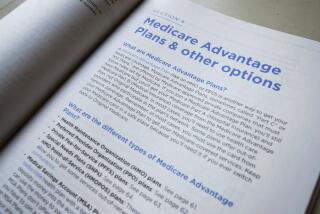Medicare’s Draft Handbook on New Drug Benefit Is Criticized
- Share via
WASHINGTON — As they gear up to sell the new Medicare drug benefit to 43 million seniors, federal health officials are circulating a draft handbook that elder advocates and insurers say is sprinkled with omissions, inaccuracies and material that could make an already complicated endeavor even more confusing.
The most glaring omission is the absence of any mention of the coverage gap euphemistically dubbed the “doughnut hole.”
Though it was one of the most contentious elements of legislation creating the new benefit, the draft makes no attempt to inform retirees that, in most cases, coverage will stop once they have spent $3,600 of their own money and will not resume until those out-of-pocket costs reach $5,100.
A senior who purchases medicine during that window would likely pay the entire cost.
The handbook, “Medicare and You,” also fails to explain that most prescription drug plans will limit which medications are covered, a system known in the private sector as a preferred drug list or formulary, according to reviews submitted by a range of interest groups.
The 100-page document also introduces unfamiliar terminology, such as “creditable coverage”; provides misleading information about how often beneficiaries can switch insurance; and uses income figures that conflict with material being distributed by the Social Security Administration.
“The web of choices facing people with Medicare is challenging to explain and comprehend,” wrote analysts at the independent Medicare Rights Center.
“But we believe that the draft handbook makes these choices even more difficult to understand, rather than less.”
Beginning Jan. 1, 2006, Medicare will offer prescription drug insurance, either as an add-on to the government’s traditional fee-for-service or as part of a comprehensive managed-care plan.
The design and contents of the handbook are critical to helping the elderly navigate the maze of choices.
“With 1 in 4 of the people on Medicare having cognitive or mental impairments, education is a real challenge,” said Tricia Neuman, director of the Medicare Policy Project at the nonprofit Kaiser Family Foundation.
“They themselves may be difficult to educate,” Neuman said. “The challenge then is reaching the people who make decisions with and for them.”
Leslie Norwalk, deputy administrator of the Centers for Medicare and Medicaid Services, acknowledged rough spots in the book, and said that is why her office has sought the detailed critiques.
“They made lots of legitimate points,” Norwalk said in an interview, adding: “We’re quite confident we’ll address the issues that arise.”
To most reviewers who examined the draft handbook, it appeared that the administration plans to change the name of the Medicare managed care program for the third year in a row.
In 2004, it was Medicare Plus Choice. Currently, it is marketed as Medicare Advantage, and the handbook introduces yet another new term: Medicare Health Plans.
A major challenge in explaining the panoply of Medicare options is balancing the need for specific detail with the overall length, said one senior lobbyist who did not wish to be identified for fear of retribution.
“We don’t want to send people a phone book,” she said.
Later this month, the government will send letters to about 20 million retirees who may qualify for a subsidy to help pay for the drug benefit.
The letters are the first step in an aggressive effort to register poor seniors, including those whose Medicaid drug coverage will end Dec. 31.
More to Read
Sign up for Essential California
The most important California stories and recommendations in your inbox every morning.
You may occasionally receive promotional content from the Los Angeles Times.













